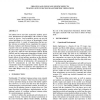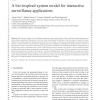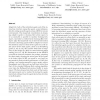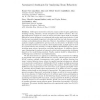594 search results - page 110 / 119 » A Simulated Student Can Improve Collaborative Learning |
WSC
2008
13 years 9 months ago
2008
US military forces now face asymmetric military operations. Management of relationships with civilians is often crucial to success. Local population groups can provide critical in...
JAISE
2011
13 years 1 months ago
2011
Advances in computer vision and pattern recognition research are leading to video surveillance systems with improved scene analysis capabilities. However, up to now few works have ...
AGENTS
2000
Springer
13 years 11 months ago
2000
Springer
Adaptivity, both of the individual agents and of the interaction structure among the agents, seems indispensable for scaling up multi-agent systems
MAS's
in noisy environme...
AAMAS
2004
Springer
13 years 7 months ago
2004
Springer
Multi-agent teamwork is critical in a large number of agent applications, including training, education, virtual enterprises and collective robotics. The complex interactions of ag...
GECCO
2009
Springer
13 years 12 months ago
2009
Springer
HyperNEAT, a generative encoding for evolving artificial neural networks (ANNs), has the unique and powerful ability to exploit the geometry of a problem (e.g., symmetries) by enc...




